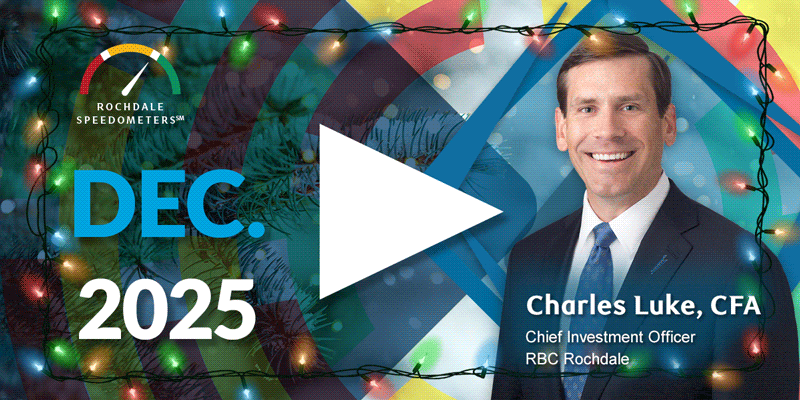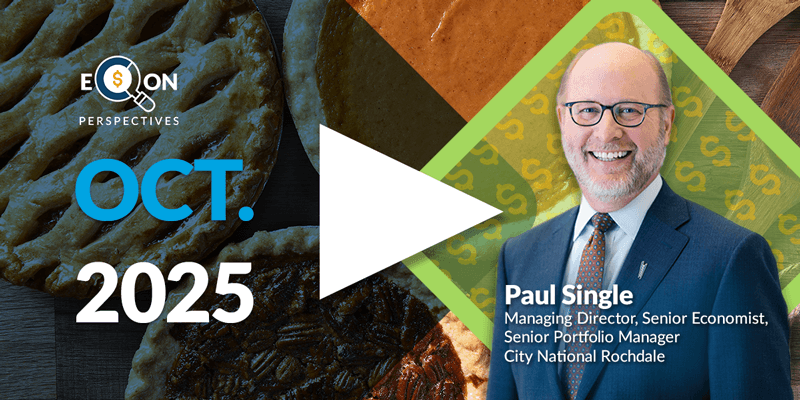-
Economic Perspectives
The Economy & Bond Yields
October 2023
- Filename
- Economic Perspectives OCTOBER 2023.pdf
- Format
- application/pdf
TRANSCRIPT
The U.S. economy is showing a great deal of resilience.
Despite the fact that the Fed has raised short-term interest rates by 525 basis points (bps), GDP growth in the third quarter looks like it may come in around 5% — at least that's what the Fed of Atlanta thinks it's going to be. That is a strong number driven heavily by consumer spending, investment and net trade.
Furthermore, inflationary pressures are moderating, and so is the pace of growth of labor, so that will help bring down inflation in the future — at least, that is what the hope is for the Fed.
Chart 1: 0:54 – For inflation, we are looking at the two most popular measurements: the consumer price index (or CPI) and Core PCE, which is a Fed-favorite measurement of inflation.
CPI is in the dark blue, and, you can see, it came down significantly from the very high level of last year, but in the last couple of months, it's eked up a little bit, mainly because energy prices have moved up as a result of higher oil prices. The lighter blue line, as I mentioned, is the one that the Fed pays attention to the most. You can see how that is continuing to move down. This, of course, takes out food and energy prices. Although it has been coming down, it is still a ways away from the 2% target that the Fed wants to see.
Chart 2: 1:38 – In terms of labor, this chart here, you can see the columns are showing the monthly change in payroll, and it does tend to be on a volatile basis month by month. So we look at the six-month moving trend, which you can see is the dark blue line, and that has moved down from the hyper-stimulated period of 2021 and early 2022. What is important here is that we are seeing, it seems, to be settling in around the same pace that we had before the pandemic started. It is more of a pace that is consistent with supply being able to meet demand, which then leads to the fact that we will not see the big wage pressures that we had seen over the last couple of years. With that subsiding, that will help bring down inflation overall.
Chart 3: 2:23 – In this chart here, is the 10-year Treasury Note. You can see over a period that it has moved up significantly. It's moved up quite a bit since then, recession, which makes an awful lot of sense because there's such a great fear at that time, but more importantly, we've seen a sharp increase just in the past few months, and the yield on the 10-year Treasury Note is something that we have not seen in more than a decade.
Now, there are many reasons for the higher yield, but it is interesting to note that the yield on the 10-year Treasury Note has moved up much more than what we've seen with short-term rates, which are dictated by the Federal Reserve Bank.
Chart 4: 3:04 – In this chart here, the solid dark line is the change in the federal funds rate since the beginning of June, where it is moved up 25 basis points, but you can see the 10-year Treasury Note during that same period of time, has moved up more than 100 basis points. This tells us that there are other concerns for bondholders that is forcing bond yields up significantly.
Term Premium Definition: 3:27 – The key issue that bond investors are looking at is something called term premium. Investors demand this extra yield for an investment of longer-dated assets. It is sort of a catchall phrase for events that are either happening in the market that is intriguing investors to come into or, in this case, scaring investors from coming into the market. They require more yield for several reasons, such as fear of higher inflation, fear of greater uncertainty or fear of greater supply coming into the market. That one is the focus right now of the market is the fact that the amount of treasury debt in the United States has increased significantly in just the past few months.
Chart 5: 4:14 – In this chart here, you can see the amount of debt that the U.S. Treasury has issued so far this year. For a long period, it did not change much because that is when we were dealing with the debt ceiling. If you look at this light blue area — this is the change since the debt ceiling was approved and signed into law at the beginning of June. It has increased more than $2 trillion.
This extra amount of debt coming into the market has scared an awful lot of investors because they are quite uncertain in terms of how much more will the Treasury be issuing. As a result, that has pushed up the term premium.
Chart 6: 4:48 – In this chart here, you can see how much it has moved just in the past few months. Now, the term premium is not an observable rate. You cannot go out and look to figure out what it is. Instead, it’s a calculation based on a very complicated algorithm, but it is an estimation of terms of what that extra yield has to be what investors are demanding. Right now, because of the great uncertainty in terms of the federal government, being able to issue an awful lot of debt has investors quite concerned, and that is what is helping to push up longer-term rates.
Summary: 5:27 – With longer-term rates moving up quite a bit, this means the Fed might not have to raise the federal funds rate again this year, even though they had made plans of one more rate increase.
For several months, we at CNR have not expected the Fed to raise rates at their November meeting, and we still hold that position. There is a lot of information that is coming out: The economy is changing very, very quickly. Yes, it was very strong in the third quarter, but we expect it to slow down quite a bit in the fourth quarter and the first quarter of next year.
Stay Informed.
Get our Insights delivered straight to your inbox.
Put our insights to work for you.
If you have a client with more than $1 million in investable assets and want to find out about the benefits of our intelligently personalized portfolio management, speak with an investment consultant near you today.
If you’re a high-net-worth client who's interested in adding an experienced investment manager to your financial team, learn more about working with us here.




